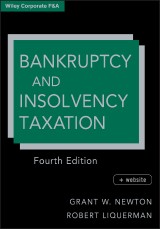Details

Bankruptcy and Insolvency Taxation
Wiley Corporate F&A, Band 576 4. Aufl.
|
196,99 € |
|
| Verlag: | Wiley |
| Format: | EPUB |
| Veröffentl.: | 06.01.2012 |
| ISBN/EAN: | 9781118172964 |
| Sprache: | englisch |
| Anzahl Seiten: | 752 |
DRM-geschütztes eBook, Sie benötigen z.B. Adobe Digital Editions und eine Adobe ID zum Lesen.
Beschreibungen
The thousands of mergers, acquisitions, and start-ups that have characterized the past years of business have created an increasing number of corporations in financial trouble: specifically, a shortage of venture capital or quick cash. Consequently, bankruptcy protection is now viewed as a strategic move to protect corporations from their creditors and allow them to reorganize. Fully revised and updated with new case studies and the latest coverage of regulations, <i>Bankruptcy and Insolvency Taxation, Fourth Edition</i> provides the answers to the questions financial managers will have on the tax aspects of bankruptcy strategy.
<p>Preface ix</p> <p><b>Chapter One: Nature of Bankruptcy and Insolvency Proceedings 1</b></p> <p> 1.1 Objectives 2</p> <p> 1.2 Alternatives Available to a Financially Troubled Business 4</p> <p><b>Chapter Two: Discharge of Indebtedness 27</b></p> <p> 2.1 Introduction 30</p> <p> 2.2 Discharge of Indebtedness Income 30</p> <p> 2.3 Determination of Discharge of Indebtedness Income 31</p> <p> 2.4 Section 108(e) Additions to Discharge of Indebtedness Income 46</p> <p> 2.5 Section 108(e) Subtractions from Discharge of Indebtedness Income 66</p> <p> 2.6 Discharge of Indebtedness Income Exclusions 71</p> <p> 2.7 Consequences of Qualifying for Section 108(a) Exclusions 81</p> <p> 2.8 Section 108(i) Deferral and Ratable Inclusion of DOI from Business Indebtedness Discharged by the Reacquisition of a Debt Instrument 97</p> <p> 2.9 Use of Property to Cancel Debt 106</p> <p> 2.10 Consolidated Tax Return Treatment 117</p> <p> 2.11 Discharge of Indebtedness Reporting Requirements 138</p> <p><b>Chapter Three: Partnerships and S Corporations: Tax Impact of Workouts and Bankruptcies 143</b></p> <p> 3.1 Introduction 144</p> <p> 3.2 Partnerships 144</p> <p> 3.3 S Corporations 161</p> <p><b>Chapter Four: Taxation of Bankruptcy Estates and Debtors 173</b></p> <p> 4.1 Introduction 174</p> <p> 4.2 Responsibility for Filing Income Tax Returns 174</p> <p> 4.3 Accounting for the Bankruptcy Estate 177</p> <p> 4.4 Accounting for the Debtor (Individual) 215</p> <p> 4.5 Summary 228</p> <p><b>Chapter Five: Corporate Reorganizations 231</b></p> <p> 5.1 Introduction 232</p> <p> 5.2 Elements Common to Many Reorganization Provisions 233</p> <p>5.3 Overview of Specific Tax-Free Reorganizations under Section 368 249</p> <p> 5.4 Acquisitive Asset Reorganizations 249</p> <p> 5.5 Stock Acquisitions 261</p> <p> 5.6 Single-Entity Reorganizations 270</p> <p> 5.7 Divisive Reorganizations 275</p> <p> 5.8 Insolvency Reorganizations 286</p> <p> 5.9 Summary 309</p> <p><b>Chapter Six: Use of Net Operating Losses 311</b></p> <p> 6.1 Introduction 313</p> <p> 6.2 I.R.C. Section 381 315</p> <p> 6.3 Restructuring under Prior I.R.C. Section 382 320</p> <p> 6.4 Current I.R.C. Section 382 322</p> <p> 6.5 I.R.C. Section 383: Carryovers Other than Net Operating Losses 396</p> <p> 6.6 I.R.C. Section 384 397</p> <p> 6.7 I.R.C. Section 269: Transactions to Evade or Avoid Tax 401</p> <p> 6.8 Libson Shops Doctrine 406</p> <p> 6.9 Consolidated Return Regulations 407</p> <p><b>Chapter Seven: Other Corporate Issues 425</b></p> <p> 7.1 Introduction 426</p> <p> 7.2 Earnings and Profits 426</p> <p> 7.3 Incorporation 430</p> <p> 7.4 Liquidation 434</p> <p> 7.5 I.R.C. Section 338 440</p> <p> 7.6 Limited Liability Corporation 454</p> <p> 7.7 Other Tax Considerations 454</p> <p> 7.8 Administrative Expenses 457</p> <p> 7.9 Other Administrative Issues 465</p> <p><b>Chapter Eight: State and Local Taxes 471</b></p> <p> 8.1 Introduction 471</p> <p> 8.2 Bankruptcy Estates 472</p> <p> 8.3 Stock for Debt 479</p> <p> 8.4 Cancellation of Indebtedness 479</p> <p> 8.5 Net Operating Loss Carryback and Carryover 480</p> <p> 8.6 Stamp Tax 481</p> <p> 8.7 Tax Impact of Plan for State and Local Purposes 485</p> <p><b>Chapter Nine: Tax Consequences to Creditors of Loss from Debt Forgiveness 487</b></p> <p> 9.1 Introduction 488</p> <p> 9.2 Nature of Losses 488</p> <p> 9.3 Business and Nonbusiness Losses 490</p> <p> 9.4 Determination of Worthlessness 501</p> <p>9.5 Secured Debt 509</p> <p> 9.6 Reorganization 516</p> <p><b>Chapter Ten: Tax Procedures and Litigation 519</b></p> <p> 10.1 Introduction 520</p> <p> 10.2 Notice and Filing Requirements 520</p> <p> 10.3 Tax Determination 521</p> <p> 10.4 Bankruptcy Courts 575</p> <p> 10.5 Minimization of Tax and Related Payments 578</p> <p><b>Chapter Eleven: Tax Priorities and Discharge 581</b></p> <p> 11.1 Introduction 582</p> <p> 11.2 Priorities 582</p> <p> 11.3 Tax Discharge 635</p> <p><b>Chapter Twelve: Tax Preferences and Liens 669</b></p> <p> 12.1 Introduction 669</p> <p> 12.2 Tax Preferences 669</p> <p> 12.3 Tax Liens 675</p> <p>About the Authors 703</p> <p>About the Web Site 704</p> <p>Statutes Citations 705</p> <p>Treasury Regulations, Revenue Procedures, and Revenue Rulings Citations 714</p> <p>Case Index 722</p> <p>Subject Index 732</p> <p> </p>
<p><strong>Grant Newton</strong>, CPA, CIRA, CMA (Medford, OR) is?the founder and President of the National Association of Insolvency Accountants. He is also the editor and contributing author of CMA Review (Malibu Publishing). Dr. Newton is a former member of the AICPA's Task Force on Financial Reporting by Entities in Reorganization Under the Bankruptcy Code, which resulted in the issuance of AICPA Statement of Position 90-7. He speaks throughout the United States on bankruptcy and insolvency matters and is frequently an expert witness on bankruptcy issues. <p><strong>Robert Liquerman</strong> (Washington, D.C.) is a principal in KPMG LLP's Washington National Tax Practice, Corporate Tax Group, specializing in matters under Subchapter C of the Internal Revenue Code. He is an adjunct professor of law in the LL.M. program at the Georgetown University Law Center and previously served as an adjunct professor in the LL.M. program at The College of William & Mary, Marshall-Wythe School of Law.?He is a frequent speaker on bankruptcy and tax issues at various tax institutes and conferences around the country.
Diese Produkte könnten Sie auch interessieren:

Counterparty Credit Risk, Collateral and Funding

von: Damiano Brigo, Massimo Morini, Andrea Pallavicini

69,99 €
















